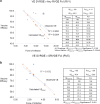Force of infection: a determinant of vaccine efficacy?
- PMID: 33846340
- PMCID: PMC8042006
- DOI: 10.1038/s41541-021-00316-5
Force of infection: a determinant of vaccine efficacy?
Abstract
Vaccine efficacy (VE) can vary in different settings. Of the many proposed setting-dependent determinants of VE, force of infection (FoI) stands out as one of the most direct, proximate, and actionable. As highlighted by the COVID-19 pandemic, modifying FoI through non-pharmaceutical interventions (NPIs) use can significantly contribute to controlling transmission and reducing disease incidence and severity absent highly effective pharmaceutical interventions, such as vaccines. Given that NPIs reduce the FoI, the question arises as to if and to what degree FoI, and by extension NPIs, can modify VE, and more practically, as vaccines become available for a pathogen, whether and which NPIs should continue to be used in conjunction with vaccines to optimize controlling transmission and reducing disease incidence and severity.
Conflict of interest statement
D.C.K., an employee of PATH (a not-for-profit organization), has no financial interest in any for-profit organization, and declares no competing interests.
Figures



Similar articles
-
Braking Force Model on Virus Transmission to Evaluate Interventions Including the Administration of COVID-19 Vaccines - Worldwide, 2019-2021.China CDC Wkly. 2021 Oct 8;3(41):869-877. doi: 10.46234/ccdcw2021.195. China CDC Wkly. 2021. PMID: 34703644 Free PMC article.
-
The Joint Impact of COVID-19 Vaccination and Non-Pharmaceutical Interventions on Infections, Hospitalizations, and Mortality: An Agent-Based Simulation.medRxiv [Preprint]. 2021 Jan 10:2020.12.30.20248888. doi: 10.1101/2020.12.30.20248888. medRxiv. 2021. Update in: JAMA Netw Open. 2021 Jun 1;4(6):e2110782. doi: 10.1001/jamanetworkopen.2021.10782. PMID: 33442712 Free PMC article. Updated. Preprint.
-
Association of Simulated COVID-19 Vaccination and Nonpharmaceutical Interventions With Infections, Hospitalizations, and Mortality.JAMA Netw Open. 2021 Jun 1;4(6):e2110782. doi: 10.1001/jamanetworkopen.2021.10782. JAMA Netw Open. 2021. PMID: 34061203 Free PMC article.
-
Lifting non-pharmaceutical interventions following the COVID-19 pandemic - the quiet before the storm?Expert Rev Vaccines. 2022 Nov;21(11):1541-1553. doi: 10.1080/14760584.2022.2117693. Epub 2022 Sep 5. Expert Rev Vaccines. 2022. PMID: 36039786 Review.
-
Comparison of COVID-19 and seasonal influenza under different intensities of non-pharmaceutical interventions and vaccine effectiveness.Front Public Health. 2022 Sep 27;10:973088. doi: 10.3389/fpubh.2022.973088. eCollection 2022. Front Public Health. 2022. PMID: 36238257 Free PMC article. Review.
Cited by
-
Analysing vaccine efficacy evaluated in phase 3 clinical trials carried out during outbreaks.Infect Dis Model. 2024 May 23;9(4):1027-1044. doi: 10.1016/j.idm.2024.05.007. eCollection 2024 Dec. Infect Dis Model. 2024. PMID: 38974900 Free PMC article.
-
A new automated national register-based surveillance system for outbreaks in long-term care facilities in Norway detected three times more severe acute respiratory coronavirus virus 2 (SARS-CoV-2) clusters than traditional methods.Infect Control Hosp Epidemiol. 2023 Sep;44(9):1451-1457. doi: 10.1017/ice.2022.297. Epub 2022 Dec 16. Infect Control Hosp Epidemiol. 2023. PMID: 36524319 Free PMC article.
-
The effect of pandemic prevalence on the reported efficacy of SARS-CoV-2 vaccines.PLoS One. 2022 Apr 5;17(4):e0266271. doi: 10.1371/journal.pone.0266271. eCollection 2022. PLoS One. 2022. PMID: 35381023 Free PMC article.
-
Effectiveness of an inactivated Covid-19 vaccine with homologous and heterologous boosters against Omicron in Brazil.Nat Commun. 2022 Oct 6;13(1):5536. doi: 10.1038/s41467-022-33169-0. Nat Commun. 2022. PMID: 36202800 Free PMC article.
-
Probiotics and probiotic-based vaccines: A novel approach for improving vaccine efficacy.Front Med (Lausanne). 2022 Oct 13;9:940454. doi: 10.3389/fmed.2022.940454. eCollection 2022. Front Med (Lausanne). 2022. PMID: 36313997 Free PMC article. Review.
References
-
- John TJImmunisation. Against polioviruses in developing countries. Rev. Med. Virol. 1993;3:149–160. doi: 10.1002/rmv.1980030305. - DOI
Publication types
LinkOut - more resources
Full Text Sources
Other Literature Sources
Medical
Research Materials

